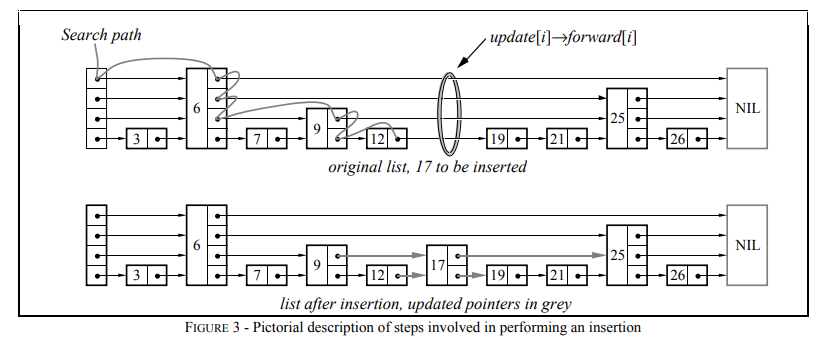参考《Redis 设计与实现》 (基于redis3.0.0) 作者:黄健宏
学习redis3.2.13
介绍
zskiplist是一个跳表,或者说跳跃表。它是一个有序链表,通过额外的空间与类似二分的查找算法,使得其对数据的查找、插入、删除操作得以快速完成,这些操作的平均时间复杂度为O(logN),最坏情况为O(N)
链表的示意图如下:

跳表的性质:
- 跳表的每个节点可以拥有不同的层级,节点的层数由抛硬币的形式确定,跳表是概率性数据结构
- 跳表的每一层都可以看做一个有序链表,只是层级越高,链接的节点就越少,查找时跳过的节点也就越多
- 跳表的最底层连接了全部的节点,如果一个节点在K被链接,那么在K层以下,该节点同样会被链接
查找示意图:

从图中,可以看到,高层链表节点稀疏,跳过的节点多,越往下节点越多,最底层链表拥有全部节点,通过从高层链表往下搜索,可以跳过很多节点,提高查找性能
注:示意图中多了尾部的哨兵节点,zskiplist不含此节点
跳表的结构
节点zskiplistNode
typedef struct zskiplistNode {
//指向具体对象, 这里暂时抛开robj的类型,只关注节点结构
robj *obj;
//节点的分值,节点排序的依据,分值小的在前,数值递增排序
double score;
//后退指针,用于连接前驱节点,反向遍历时使用
struct zskiplistNode *backward;
//层级数组
struct zskiplistLevel {
//前进指针,用于连接后继节点
struct zskiplistNode *forward;
//指针前进跨度,记录当前节点到后继节点的距离
//当前节点为尾节点时,值为0,表示不与任何节点连接
unsigned int span;
} level[];
} zskiplistNode;节点内的层级又是一个柔性数组,使用柔性数组的好处前面已经多次说明,这里就不再赘述了,由于从上层往下层查找,并且被上层链接的节点一定会被下层链接,所以也不用记录柔性数组长度也不会发生内存访问错误。
使用柔性数组作为层级来在每层共用节点,而不是将每层当作单独的链表,使用指向下层的指针连接, 减少了实现的复杂度,节省了内存,可以说真的很巧妙
管理结构定义
typedef struct zskiplist {
//头、尾节点,头结点不存储数据
struct zskiplistNode *header, *tail;
//跳表拥有节点个数(不计头结点)
unsigned long length;
//跳表中层数最高节点的层数(不计头结点)
int level;
} zskiplist;跳表的创建与释放
跳表中节点最高层限制在了32,为了从上到下遍历,创建时,将头结点创建为32层,并初始化每一层
#define ZSKIPLIST_MAXLEVEL 32 /* Should be enough for 2^32 elements */
zskiplist *zslCreate(void) {
int j;
zskiplist *zsl;
zsl = zmalloc(sizeof(*zsl));
zsl->level = 1;
zsl->length = 0;
zsl->header = zslCreateNode(ZSKIPLIST_MAXLEVEL,0,NULL);
for (j = 0; j < ZSKIPLIST_MAXLEVEL; j++) {
zsl->header->level[j].forward = NULL;
zsl->header->level[j].span = 0;
}
zsl->header->backward = NULL;
zsl->tail = NULL;
return zsl;
}
void zslFree(zskiplist *zsl) {
zskiplistNode *node = zsl->header->level[0].forward, *next;
zfree(zsl->header);
while(node) {
next = node->level[0].forward;
zslFreeNode(node);
node = next;
}
zfree(zsl);
}
zskiplistNode *zslCreateNode(int level, double score, robj *obj) {
zskiplistNode *zn = zmalloc(sizeof(*zn)+level*sizeof(struct zskiplistLevel));
zn->score = score;
zn->obj = obj;
return zn;
}
void zslFreeNode(zskiplistNode *node) {
decrRefCount(node->obj);
zfree(node);
}插入节点
结合示意图来看,更便于理解

注释已经写得很详细了,就不对代码逻辑进行额外说明了。
zskiplistNode *zslInsert(zskiplist *zsl, double score, robj *obj) {
//update数组用于记录每层待插入节点的前驱节点
zskiplistNode *update[ZSKIPLIST_MAXLEVEL], *x;
//记录每层内,待插节点前驱节点的排名
unsigned int rank[ZSKIPLIST_MAXLEVEL];
int i, level;
//nan无法排序,此处做一个判断
serverAssert(!isnan(score));
//由头结点开始往后寻找
x = zsl->header;
//由高层向低层,在每层寻找新节点的前驱节点x,完成插入后,前驱节点的后继就是新插入节点
/*因为节点层数高的概率小,所以层数高的节点少,高层级节点间跨度大,从上层开始找时,可跳过部分节点,所以看似O(n^2)的实现,实际O(NlogN)*/
for (i = zsl->level-1; i >= 0; i--) {
/* store rank that is crossed to reach the insert position */
//当位于顶层节点时,运行到此处,x还指向头结点,未跨过任何节点,跨度为0
//当不位于顶层节点时,说明当上一层寻找完毕,x刚由上一层切换到本层,由于是同一个节点,所以排名是一样的,记录下来,后续在本层进行寻找时使用
rank[i] = i == (zsl->level-1) ? 0 : rank[i+1];
//在i层中寻找前驱节点 寻找时,对比分值,分值一致就对比存储对象的大小
while (x->level[i].forward &&
(x->level[i].forward->score < score ||
(x->level[i].forward->score == score &&
compareStringObjects(x->level[i].forward->obj,obj) < 0))) { //二进制安全对比
//记录在i层里寻找前驱节点时,经过的跨度
rank[i] += x->level[i].span;
//往后继节点迭代
x = x->level[i].forward;
}
//将i层里找到的前驱节点记录,等待后续插入使用
update[i] = x;
//i层查找结束,继续从x节点的下一层开始往后寻找
}
/* we assume the key is not already inside, since we allow duplicated
* scores, and the re-insertion of score and redis object should never
* happen since the caller of zslInsert() should test in the hash table
* if the element is already inside or not. */
level = zslRandomLevel(); //计算随机值,后续作为新节点的层数
//新节点的层数超出了skiplist原有节点中最大已有层数,头结点超出部分的层数将会被使用,将其记录到update供后续使用
if (level > zsl->level) {
for (i = zsl->level; i < level; i++) {
rank[i] = 0;
update[i] = zsl->header;
update[i]->level[i].span = zsl->length;
}
zsl->level = level;
}
x = zslCreateNode(level,score,obj);
//由低层往高层插入节点 将新节点x插入于前驱节点update[i]与update[i]后继节点之间,插入通过更新同层内前进指针(后继指针)实现
for (i = 0; i < level; i++) {
//先在新节点x的i层后,链接update[i]的后继节点,以避免i层后继节点丢失
x->level[i].forward = update[i]->level[i].forward;
//再在update[i]的i层后链接新节点x
update[i]->level[i].forward = x;
/* update span covered by update[i] as x is inserted here */
//rank[0]为新节点x前驱节点在最低层的排名 rank[i]为新节点前驱节点在i层的排名
x->level[i].span = update[i]->level[i].span - (rank[0] - rank[i]);
update[i]->level[i].span = (rank[0] - rank[i]) + 1; //由于新节点插入,前驱节点需增加1
}
/* increment span for untouched levels */
for (i = level; i < zsl->level; i++) {
update[i]->level[i].span++;
}
//设置新节点x的后退指针
x->backward = (update[0] == zsl->header) ? NULL : update[0];
if (x->level[0].forward)
x->level[0].forward->backward = x; //x的后继节点的后退指针
else
zsl->tail = x;
zsl->length++;
return x;
}计算节点最大层数
在为节点计算层数时,每次循环有0.25的概率将层数增加1
选择0.25而不是0.5是因为前者能提供更好的常数因子

#define ZSKIPLIST_P 0.25 /* Skiplist P = 1/4 */
int zslRandomLevel(void) {
int level = 1;
while ((random()&0xFFFF) < (ZSKIPLIST_P * 0xFFFF))
level += 1;
return (level<ZSKIPLIST_MAXLEVEL) ? level : ZSKIPLIST_MAXLEVEL;
}删除节点
删除节点时,对节点x每层的前驱节点的查找过程与插入节点一致,由于可能有多个节点有同样的score,需要再对比一下object对象是否一致才能进行节点删除操作,删除时先将节点从跳表中移除,再释放节点占用的内存
int zslDelete(zskiplist *zsl, double score, robj *obj) {
zskiplistNode *update[ZSKIPLIST_MAXLEVEL], *x;
int i;
x = zsl->header;
for (i = zsl->level-1; i >= 0; i--) {
while (x->level[i].forward &&
(x->level[i].forward->score < score ||
(x->level[i].forward->score == score &&
compareStringObjects(x->level[i].forward->obj,obj) < 0)))
x = x->level[i].forward;
update[i] = x;
}
/* We may have multiple elements with the same score, what we need
* is to find the element with both the right score and object. */
x = x->level[0].forward;
if (x && score == x->score && equalStringObjects(x->obj,obj)) {
zslDeleteNode(zsl, x, update); //将节点x从跳表中移出
zslFreeNode(x); //释放x
return 1;
}
return 0; /* not found */
}
##将节点从跳表中移除移除待删节点
通过前面的删除函数,我们得到了待删节点x, x在每层的前驱节点数组update
移除时,更新前驱节点在每层的跨度、前进指针,如果x不是尾节点,更新其后置节点的后退指针,否则重设尾节点,最后更新最大层数(当最高层没有连接到任何节点时)及节点个数
void zslDeleteNode(zskiplist *zsl, zskiplistNode *x, zskiplistNode **update) {
int i;
for (i = 0; i < zsl->level; i++) {
if (update[i]->level[i].forward == x) {
update[i]->level[i].span += x->level[i].span - 1;
update[i]->level[i].forward = x->level[i].forward;
} else {
update[i]->level[i].span -= 1;
}
}
if (x->level[0].forward) {
x->level[0].forward->backward = x->backward;
} else {
zsl->tail = x->backward;
}
while(zsl->level > 1 && zsl->header->level[zsl->level-1].forward == NULL)
zsl->level--;
zsl->length--;
}释放节点
释放时,减少被存储对象的引用计数,并释放节点本身占用的内存
void zslFreeNode(zskiplistNode *node) {
decrRefCount(node->obj);
zfree(node);
}性能比较

参考资料
Skip Lists: A Probabilistic Alternative toBalanced Trees
Skip Lists